Correct cultivation of ficus at home
Ficus - tropical plant. This name brings together about 1000 species. Some of them are successfully grown at home.
Content:
- Ficus: description
- Reproduction, planting, formation of the crown of the ficus
- Ficus care
- Ficus transplant
- Ficus pests and diseases
Ficus: description
Ficus - a plant known to our grandmothers. But they cultivated mainly one of its species. For several years, he grew to the ceiling and began to bring certain inconveniences to the owners. But for several decades, new species of this plant have conquered the hearts of flower growers. Ficus belongs to the mulberry family. It grows wild in the tropics and subtropics. There are several types of ficuses according to the type of plant formation:
- Bushes
- Vines
- Trees
Lianas are growing upward and ampelous. All types of ficuses are united by the presence of white juice, called milky. Most of the species are evergreen. But some still shed their leaves. All ficuses have rounded leaves with a pointed tip. They can be monochromatic, with some alternating green with light green or white, sometimes pink or yellow. Their size is also different, from 10 centimeters to several centimeters. The inflorescences are similar to a berry with a hole in which small flowers are visible: separately male and female.
Ficus is widespread due to the discreet beauty of the leaves, rather simple care.
Popular types of ficuses:
- Benjamin with small, often variegated, leaves
- Rubbery with relatively large leaves.
- Lyre-shaped
- Dwarf
- Bengal
Reproduction, planting, formation of the crown of the ficus
Ficus reproduces cuttings, layering and seeds. The last method is impractical to use.
Ficus cuttings:
- For propagation by cuttings in spring or summer, cut tops up to 15 cm long.
- They are treated with a growth stimulant. Set in a pot with prepared light soil.
- Cover the stalk with a glass jar or bag. A heating pad is placed under the jar from below. The stalk is periodically ventilated. After rooting, they gradually leave it open, and then completely remove the jar.
- You can root this stalk in warm water by adding charcoal (tablet) there. Placed in a jar protected from light. They cover from above by arranging a mini-greenhouse. It will not be difficult to notice the roots. The stalk is planted in a pot.
- The soil consists of equal parts of turf and greenhouse land and sand. Hardwood can be taken twice as much. This will make the soil loose. Humus is also added.
- Drainage during planting is required. It can be expanded clay or fine gravel. Chunks of charcoal will prevent the roots from rotting if accidentally overflowed with water.
- The plant is immersed in a pot and sprinkled with earth. The soil is slightly compacted.
The crown of the ficus can be formed using pruning and pinching. The operation is performed in the spring. The central stem is cut so that it is 1 m high when grown on the floor and 40 cm when grown on a table. At a time, no more than 20 cm is cut, and the number of leaves should remain at least 5.
The crown can be formed from several ficuses, planting them in a circle in one pot and intertwining with each other. So you can achieve the original openwork shape of the bush.
Ficus care
Each type of ficus has its own characteristics of care. But there are rules, the observance of which will allow you to successfully grow any of them.
- In the spring, the temperature in the room should be between 23 and 27 degrees. Ficus feels good in the summer in the garden. You just need to protect it from drafts. In winter, you need to lower it by 7-8 degrees. Like any tropical plant, he does not like hypothermia of the soil. The reaction to this may be the dropping of leaves. The plant also reacts to drafts.
- Ficus is picky about soil moisture. The plant does not tolerate drying out well. But even worse for him is the stagnation of moisture in root system... It leads to the fact that the roots rot, and the ficus disappears. Therefore, you must not pour water into the sump. Ficuses are watered infrequently. The soil should dry well between watering. In the summer it is about once a week. In winter, it is enough to water it once every 10 days with warm, settled water.
- The location of the ficus is of great importance. It is not installed near radiators or other heat sources. Better not to transfer from one place to another. Placed on the east and west windows. Can be placed on the south window, if there is any shading. It could be a tree outside the window. Direct sunlight can burn leaves. Ficuses with variegated leaves are more demanding in terms of room illumination. If it is insufficient, then the leaves may fall off. But even species with monochromatic leaves, when kept in a dark room, stretch out and become unattractive.
- Tropical plants grow well in high humidity. Therefore, their leaves in the summer need to be regularly spray warm water. This is especially important for small-leaved species.
- Ficus leaves are wiped with a damp sponge. It responds well to washing away dust under the shower. In order not to flood the soil with water during the procedure, it is covered with a film.
- In order for the ficus to grow well, it needs to be fed periodically. They do this from spring to autumn, during a period of active growth. Use organic and mineral fertilizers... It's good if they alternate. Before fertilizing, the soil is moistened. Foliar dressing is not carried out. Fertilizer should not get on the leaves.
Ficus transplant
How often it is needed depends on the age of the ficus transplant... This is done every year at first. Each time the size of the pot is increased by 3 cm. Then you can limit yourself to a transplant every two years.
It is quite difficult to transfer mature plants to a new pot. Therefore, you can remove the topsoil and replace it with a new, nutrient-rich, loose soil. It provides drainage of the soil. At the same time, you need to be extremely careful with the roots, try not to violate their integrity. The plant will indicate the time of transplanting itself. Usually it is carried out when the roots of the plant cease to fit in the pot. They can crawl through holes in the bottom.
Transplant is carried out in the spring, before the start of the active growing season:
- First, the roots are moistened so that it is possible to stretch the bush. Leave for a while, so that the soil moves away a little.
- Prepare the pot and soil for transplanting. It may be slightly denser than for planting cuttings. Remember to update the drainage.
- They loosen the soil, trying to separate it from the pot. Carefully remove the plant. With a wooden stick or hand, remove the old earth from the roots.
- If the roots are heavily sprouted, they can be shortened by carefully cutting with pruning shears. Then it is sprinkled with coal so that the wounded parts do not rot.
- After transplanting, leave the pot with the plant in a dark, cozy place for 2 days. This will activate the roots.
The plant is tied to a support set a few centimeters from the stem. First, they tie the string to the support, then twine it around the stem with an eight, circle it around the support and tie it from the outside.
It is advisable to propagate by layering if the trunk of the ficus is bare.
An incision is made on the trunk with a knife or blade. It is treated with a growth stimulant. A layer of durable material is installed in the place of the notch. It will help keep some distance between the cut edges. To prevent moisture from leaving the incision site, isolate it with moss, on top - with plastic wrap, and fix the bandage. When roots begin to sprout through the moss, the cut is cut off. They are planted in a pot in a permanent place. The rest can be left by treating the cut with petrolatum.
Ficus pests and diseases
If the lower leaves dry and fall off, you need to water it. If they turn yellow and fall off, this indicates their waterlogging. You need to reduce the frequency or amount of watering. When the ficus stopped growing, the leaves became pale, you need to fertilize the soil in the pot.
If the leaves quickly wilt, turn yellow, then become dark, there is reason to suspect root rot.
It occurs due to fungal infection due to increased soil moisture in the pot. If you manage to determine the cause of the disease in time, you can try to save the plant. To do this, they bring the plant out into the light, carefully examine the roots. When most of them are alive and not affected by disease (light-colored), it is easier to treat it. Remove all affected parts of the roots and leaves, process the cut sites, and the entire root system with potassium permanganate, leave in the air for a couple of days (not in the sun). Then transplant in another pot (you can disinfect, but this does not always help). Spill with carbendazim solution.
For more severe damage pruning make the maximum, including the upper part of the plant. After all, he practically will not have a root system that could take care of the nutrition of the stem. After planting in new soil, spill with carbendazim and set away from direct sunlight. Watering begins only after the plant begins to develop.
The appearance of brown spots on the edges of the leaves indicates improper housing conditions. It is necessary to lower the temperature in the room, increase the humidity (spray), reduce the amount of fertilizer applied.
More information can be found in the video:
Ficus pests:
- Mealybug. Woolly spots indicate the defeat of the leaves of the old ficus with a mealybug. These are colonies of bristly insects up to 5 mm long. To get rid of it, rub the leaves with methyl alcohol. Can be treated with karbofos or any insecticide. Old ficuses are more often affected in a dry and hot room.
- Red spider mite. If the leaves are covered with yellow spots, and a cobweb appears from below, your ficus damages the spider mite. This is the most dangerous pest... Spray the plant with derris, actellik or any insecticide. Humidify the air in the room, regularly wipe the leaves with a damp sponge.
- Shield. Scabbards can be seen with the naked eye. These are small, scaly brown insects. Their appearance is evidenced by sticky sap on the leaves and their yellowing. Fight in the same way as with a mealybug. But achieving a positive result is more difficult. After all, a shield protects adults from the effects of an insecticide. Therefore, most likely, the places where the scale insects will have to be removed along with the part of the plant on which they sit. The scale insect, like other pests, is dangerous for the mother-in-law and that over time it spreads to other flowers.
You can fight these pests with a folk remedy - a soap-oil emulsion. Take 5 tbsp. tablespoons of washing powder and machine oil or diesel fuel. The powder is first diluted in water. Stir and pour into a bucket of water. Leaves are periodically washed with a solution. The shelf life of the product is not limited.
Folk remedy for the fight against scabies - a mixture obtained from garlic, soap and water. Garlic (1 tsp) and soap (1 tsp) are crushed, diluted with water (3 tsp). The stem and leaves of the ficus are washed. After a day, wash off with water. The procedure is repeated several times.
Heals ficus difficult, so you need to regularly inspect the plant so as not to miss the appearance of pests.



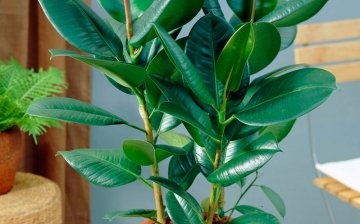
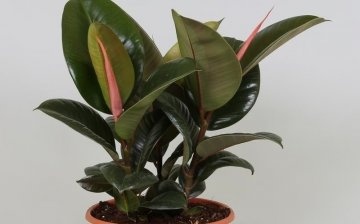

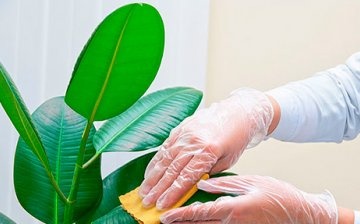
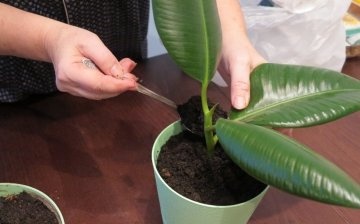







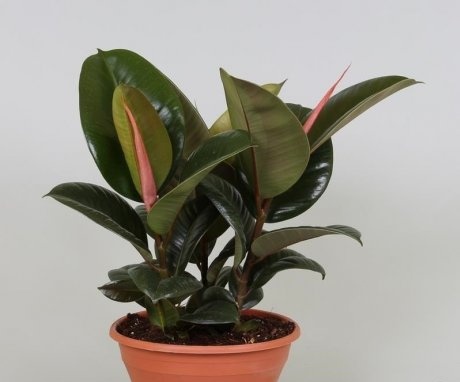

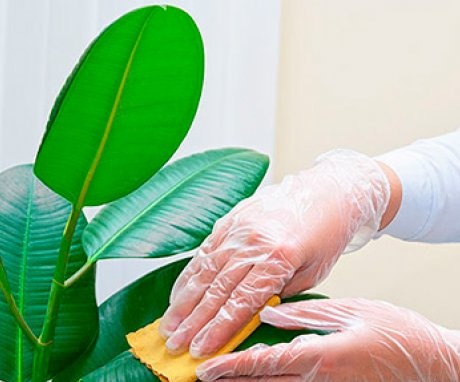
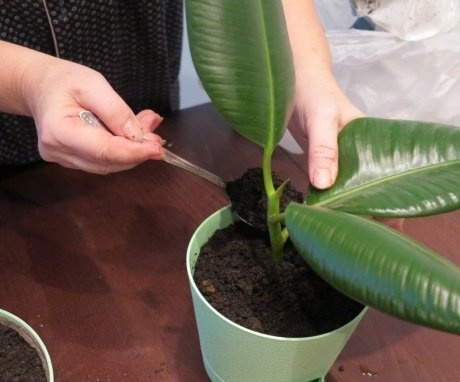

We have been growing ficus for several years. It looks like a small tree. We water it once a week, but we rarely feed it. The ficus in the apartment is in a room by the northwest-facing window. Despite the fact that there is little sunlight in the room, the ficus grows quite normally.